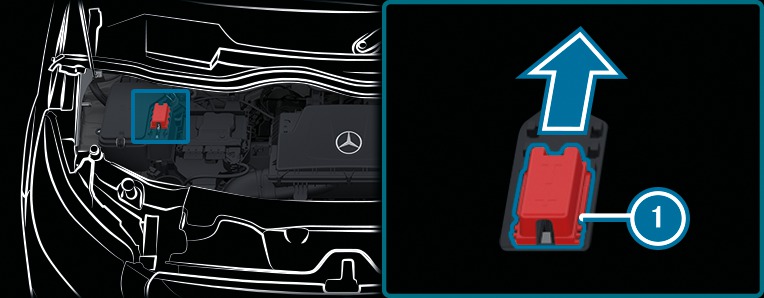A discharged battery may freeze at temperatures slightly above or below freezing point.
During starting assistance or battery charging, battery gas can be released.
If the warning/indicator lamps do not light up in the instrument cluster at temperatures around or below freezing, it is highly probable that the discharged battery has frozen.
do not give the vehicle starting assistance or charge the battery
the service life of a battery that has been thawed may be reduced drastically
the starting behaviour may deteriorate, particularly at low temperatures
it is recommended that you have a thawed battery checked at a qualified specialist workshop
During the charging process and starting assistance, the battery may release an explosive gas mixture.
Battery acid is caustic.
Numerous or extended attempts to start the engine may damage the catalytic converter due to non-combusted fuel.
Do not use a rapid charging device to start the vehicle. If your vehicle's battery is discharged, the engine can be jump-started from another vehicle or from a donor battery using jump leads. For this purpose, the vehicle has a jump-start connection point in the engine compartment.
The battery is not accessible in all vehicles. If the other vehicle's battery is not accessible, starting assistance is to be provided using a donor battery or a starting assistance device.
You may only jump-start the vehicle when the engine and exhaust system are cold.
Do not start the engine if the battery is frozen. Let the battery thaw first.
Starting assistance may only be provided using batteries with a nominal voltage of 12 V.
Only use jump leads that have a sufficient cross-section and insulated terminal clamps.
If the battery is fully discharged, attach the donor battery for a few minutes before attempting to start. This charges the discharged battery a little.
Make sure that the two vehicles do not touch.
Jump leads and further information regarding starting assistance can be obtained at any qualified specialist workshop.
The jump leads are not damaged.
Parts of the terminal clamps which are not insulated do not come into contact with other metal parts while the jump leads are connected to the battery.
The jump leads do not touch moving parts when the engine is started and while it is running, such as the V-belt pulley or the fan.
 .
. 
 of the jump-start connection point towards the rear of the vehicle against the spring pressure as far as it will go.
of the jump-start connection point towards the rear of the vehicle against the spring pressure as far as it will go. The jump-start connection point is visible.

 of the donor battery.
of the donor battery.  of the donor battery, and then to positive terminal
of the donor battery, and then to positive terminal  of the jump-start connection point.
of the jump-start connection point.  of the donor battery, and then to earth contact
of the donor battery, and then to earth contact  of your own vehicle.
of your own vehicle.  and then from negative terminal
and then from negative terminal  of the donor battery.
of the donor battery.  on the jump-start connection point, and then from positive terminal
on the jump-start connection point, and then from positive terminal  of the donor battery.
of the donor battery. Contact protection cover  is automatically returned forwards to its original position by the spring force and the jump-start connection point is closed.
is automatically returned forwards to its original position by the spring force and the jump-start connection point is closed.
 of the donor battery.
of the donor battery. Charging a fitted battery with a battery charger which has not been approved by Mercedes-Benz can damage the on-board electronics.
A battery charger specially adapted for Mercedes-Benz vehicles and tested and approved for Mercedes-Benz is available as an accessory.
Further information is available from any Mercedes-Benz Service Centre. Read the operating instructions for your charger before charging the battery.
Recharge the battery more frequently if you use the vehicle mainly for short trips and/or drive at low outside temperatures.
If a battery is not fitted and not in service, you should charge it every three months. This helps to counteract self-discharging and prevent damage to the battery.
Dirty battery terminal clamps and battery surfaces cause leakage currents. This can lead to the battery discharging.
If you use cleaning agents containing fuel, these can damage the battery housing.
If dirt gets into the battery cell, the self-discharge of the battery is increased and the battery can be damaged.
Observe the following points on battery care:

